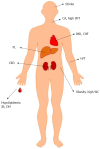Metabolic alterations and hepatitis C: From bench to bedside
- PMID: 26819514
- PMCID: PMC4721980
- DOI: 10.3748/wjg.v22.i4.1461
Metabolic alterations and hepatitis C: From bench to bedside
Abstract
In addition to causing cirrhosis and hepatocellular carcinoma, hepatitis C virus (HCV) is thought to cause hypolipidemia, hepatic steatosis, insulin resistance, metabolic syndrome, and diabetes. The viral life cycle of HCV depends on cholesterol metabolism in host cells. HCV core protein and nonstructural protein 5A perturb crucial lipid and glucose pathways, such as the sterol regulatory element-binding protein pathway and the protein kinase B/mammalian target of rapamycin/S6 kinase 1 pathway. Although several lines of transgenic mice expressing core or full HCV proteins exhibit hepatic steatosis and/or dyslipidemia, whether they completely reflect the metabolic alterations in humans with HCV infection remains unknown. Many cross-sectional studies have demonstrated increased prevalences of metabolic alterations and cardiovascular events in patients with chronic hepatitis C (CHC); however, conflicting results exist, primarily due to unavoidable individual variations. Utilizing anti-HCV therapy, most longitudinal cohort studies of CHC patients have demonstrated the favorable effects of viral clearance in attenuating metabolic alterations and cardiovascular risks. To determine the risks of HCV-associated metabolic alterations and associated complications in patients with CHC, it is necessary to adjust for crucial confounders, such as HCV genotype and host baseline glucose metabolism, for a long follow-up period after anti-HCV treatment. Adipose tissue is an important endocrine organ due to its release of adipocytokines, which regulate lipid and glucose metabolism. However, most data on HCV infection and adipocytokine alteration are inconclusive. A comprehensive overview of HCV-associated metabolic and adipocytokine alterations, from bench to bedside, is presented in this topic highlight.
Keywords: Cardiovascular; Core; Glucose; Hepatitis C virus; Lipid; Nonstructural protein 5 A; Transgenic mice.
Figures




References
-
- Koike K, Tsutsumi T, Yotsuyanagi H, Moriya K. Lipid metabolism and liver disease in hepatitis C viral infection. Oncology. 2010;78 Suppl 1:24–30. - PubMed
Publication types
MeSH terms
Substances
LinkOut - more resources
Full Text Sources
Other Literature Sources
Medical

